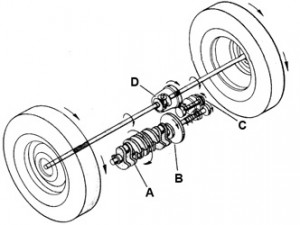Each stroke is the movement of the piston from one end of the cylinder to the other. The four strokes are called Intake, Compression, Power, and Exhaust.
Fuel injectors atomize the fuel by pumping it through a small nozzle under high pressure. Atomizing the fuel is the process of breaking it into a fine misted spray.
A complete revolution of the steering wheel is 360 degrees. Thus, the steering ratio is 360:20 which reduces to 18:1 (360/20=18).
The legs of an inside caliper measure the distance between the two inside edges of an object. This is a tool for measuring the internal size of an object.
The boiling points of liquids are increased with increased pressure. And conversely, liquids boil much more quickly at high altitude (like at the top of Mount Everest) and can leave boiled foods uncooked.
The bead is the inner edge of a tire. It is normally made with high-strength rubber and is reinforced with steel wire.

A differential allows cars to rotate at different speeds as the car goes around a corner. It helps the drive axle split the power between the two drive wheels.
Disc brakes slow the rotation of the wheels using friction, which is created by pushing the brake pads against the brake discs with a set of calipers.
A car’s electrical system controls lighting, starting, charging, and accessories.
The clutch is part of the drive train system.
During the intake step, the engine receives fuel to burn. Then the fuel is compressed, then the fuel is burned (power), then the exhaust is released.
After being collected in the exhaust manifold, exhaust gases are then sent to the catalytic converter where toxic pollutants are converted into less toxic compounds by catalyzing a redox reaction.
The chuck is the part of a drill that holds the bit. A chuck key is used to tighten and loosen a drill bit. Handily, the chuck of some drills are now adjustable by hand and do not require a key.
As pictured above, the fuel pressure regulator regulates pressure in the fuel rail according to intake manifold vacuum.
The angle of the two cylinder banks makes a "V" shape.
The torque converter is a type of fluid coupling that connects the engine to the transmission.
During this process, the electric arc give off a dangerously high-intensity light: ultraviolet light. Welders must use protection or risk burning their skin and eyes.
To loosen or tighten a bolt, you should use a socket that matches exactly the measurement of the bolt.